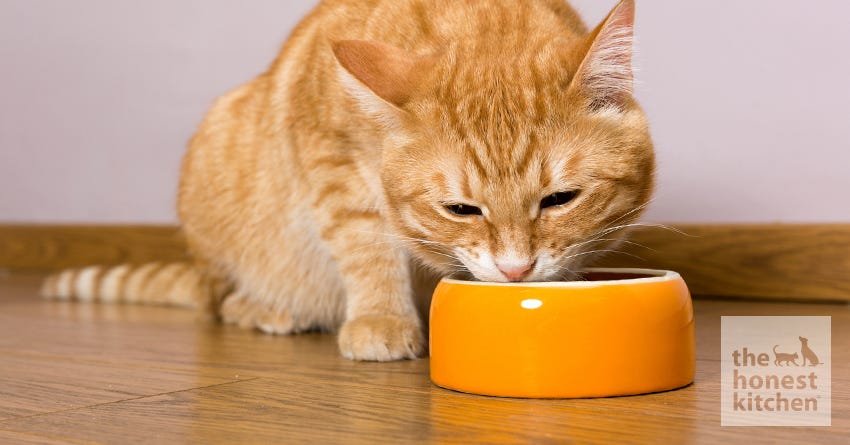Cats can be finicky eaters, so it can be tempting to keep your feline friend on the same food indefinitely. After all, who wants to deal with the hassle of trying to switch a picky cat to a new food?
In reality, though, most cats will benefit from switching to a different food at some point — and there may even be times when switching your cat’s food is necessary, and keeping them on the same food for years may be doing them a disservice. With a better understanding of when to make the change and how to do it as seamlessly as possible, you can take steps to improve your cat’s health and wellness.
Reasons To Consider Switching Cat Food
As convenient as it may be to keep your cat on the same food they've been eating forever, there are actually many good reasons to make a change in your cat's diet. You should always consult with your veterinarian before making any significant changes to your cat’s diet, but there are a few red flags that may signal that it’s time to consider switching up your cat’s food.
If you notice any of the following signs, first speak with your vet about your concerns to rule out any serious underlying conditions and treatment options. Once you determine that nothing more sinister is causing the following conditions, speak with your vet about trying a new diet.
Your Cat Is Gaining Weight and Becoming Overweight or Obese
According to a Cornell University article, about 50% of cats seen at veterinary clinics nationwide are overweight or obese. If your cat falls into this category, it may be worth asking your veterinarian about switching to a new food.
Specifically, look for a higher quality pet food that will give your cat the necessary nutrients while scaling back on the calories. Your vet can go over your cat’s feeding habits and the type and the amount of food you’re using, and will offer alternatives or suggestions as they see fit based on their assessment of your pet.
Read TrueStories from customers that helped their cat lose weight >
Your Cat Has Digestive Issues
Does your cat have a sensitive stomach? If so, then it's important to find a formula that will be gentle on your cat's digestive system while meeting all of their nutritional needs. Low-quality food or food sensitivities can cause digestive issues for your cat. These problems are often resolved with a premium diet that contains high-quality, human-grade ingredients. Many pet parents also find that cat food with a probiotic can help to reduce digestive upset while promoting better digestive health overall.
Read TrueStories from customers that saw an improvement in their cat’s digestion >
Your Cat's Coat Has Become Dull or Itchy
If you've noticed that your cat's once-shiny coat has become dull or that your cat is scratching more than normal, this could also be related to their diet. Often, flaky and itchy skin in cats is caused by a lack of fatty acids (such as omega-3 and omega-6 fatty acids) in their diet. Look at the nutritional label on your cat’s current food to ensure there’s omega-3 and omega-6 fatty acids in the recipe. If your current cat food doesn't contain these ingredients, it may be time to make the switch to a formula that does.
Much like with humans, itchy skin in cats can also be caused by food allergies. If you suspect that your cat may be allergic to an ingredient in their current food, consult with your veterinarian. They may recommend a limited ingredient diet, which can reduce exposure to potential allergens.
Read TrueStories from customers that saw an improvement in their cat’s skin and coat >
Your Cat Is Lethargic
Just as you may feel sluggish after eating something unhealthy, cats can feel the same way when they're not getting the nutrients they need out of their kibble. If you notice that your cat has less energy than normal, it's a good idea to have your vet assess them for underlying health issues. If everything checks out, the solution may be as simple as upgrading to a new cat food with higher quality ingredients.
Read TrueStories from customers who saw an improvement in their cat’s energy levels >
Your Cat Is Getting Older
A cat's nutritional needs evolve with each new life stage. For example, a growing kitten will need kitten food with lots of meat-based protein and calcium for healthy growth. With an adult cat, you'll want to be more focused on finding a food with a good balance of fat and protein. Senior cats, on the other hand, may do better with a wet cat food or pate that will provide additional hydration.
In most cases, senior cats aren’t as playful or energetic as young cats and kittens, and by virtue of that alone, their intake requirements will differ across a number of nutritional macros. A food that’s formulated specifically for older cats will contain fewer calories, higher levels of fiber, and ingredients that support the health of a senior cat (including antioxidants and joint support supplements). With the guidance of your vet, you’ll want to reassess your cat’s food at each life stage to ensure you’re meeting their present specific needs.
Read TrueStories from customers with senior cats >
4 Tips for Seamlessly Switching Cat Foods
So, after speaking with your veterinarian you decide to ditch your cat's current food in favor of something better. But, how exactly do you go about making the switch to a new type of food?
1. Create a Private, Quiet Eating Area
Cats are more comfortable eating when they have a private, safe space with no perceived threats nearby. If you haven't done so already, get your cat used to eating in a dedicated space that's quiet and separated from the hustle and bustle of your main living area.
2. Follow a Transition Schedule
Rather than making the switch to a new food all at once, many pet owners find success following a gradual transition to a new diet. We recommend spending 7-14 days transitioning your cat to new foods. Consider this sample transition schedule to help you get started:
- Day 1-3: 75% old food, 25% new food
- Day 4-6: 50% old food, 50% new food
- Day 7-9: 75% old food, 25% new food
- Day 10: 100% new food
3. Consider Adding Wet Food to Dry Food
If you’re moving to a new type of kibble and your cat seems to be resisting the new food, you may want to try adding a small amount of wet food to the new kibble. This can make it more enticing to pickier cats, and make them more likely to try it.
4. Warm Up Cold or Refrigerated Wet Food Before Feeding
If you’re feeding your cat canned food from the fridge, consider warming it up in a microwave-safe dish before giving it to your cat. Warm food is much more attractive to these instinctive hunters, as it’s closer to the body temperature of their prey and gives off more scent than cold food.
Switch to The Honest Kitchen's All-Natural Cat Food Today
Finding the optimal food to fuel your feline friend can feel like an overwhelming task, but it doesn't have to be. At The Honest Kitchen, we specialize in high-quality cat and dog food (plus treats) for every life stage. Check out our selection of nutritious cat food and pounce at the opportunity to optimize your cat's health!

